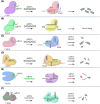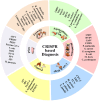CRISPR/Cas system and its application in the diagnosis of animal infectious diseases
- PMID: 39726403
- PMCID: PMC11671863
- DOI: 10.1096/fj.202401569R
CRISPR/Cas system and its application in the diagnosis of animal infectious diseases
Abstract
Infectious diseases are a serious threat to the existence of animals and humans' life. In the 21st century, the emergence and re-emergence of several zoonotic and non-zoonotic global pandemic diseases of socio-economic importance has affected billions of humans and animals. The need for expensive equipment and laboratories, non-availability of on-site testing abilities, with time-consuming and low sensitivity and specificity issues of currently available diagnostic techniques to identify these pathogenic micro-organisms on a large scale highlighted the need for developing cheap, portable environment friendly diagnostic methods. In recent years, these issues have been addressed by clustered regularly interspaced palindromic repeats (CRISPR)-based diagnostic platforms that have transformed the molecular diagnostic field due to their outstanding ultra-sensitive nucleic acid detecting capabilities. In this study, we highlight the types, potential of different Cas proteins, and amplification systems. We also illuminate the application of currently available CRISPR integrated setups on the diagnosis of infectious diseases, majorly in food-producing animals (pigs, ruminants, poultry, and aquaculture), domestic pets (dogs and cats), and diseases of zoonotic importance. We conclude the challenges and future perspectives of using these systems to rapidly diagnose and treat other infectious diseases and also develop control strategies to prevent the spread of pathogenic organisms.
Keywords: CRISPR/Cas systems; applications; biosensor; infectious disease; molecular diagnostics; point‐of‐care.
© 2024 The Author(s). The FASEB Journal published by Wiley Periodicals LLC on behalf of Federation of American Societies for Experimental Biology.
Figures




Similar articles
-
CRISPR-Cas systems for diagnosing infectious diseases.Methods. 2022 Jul;203:431-446. doi: 10.1016/j.ymeth.2021.04.007. Epub 2021 Apr 9. Methods. 2022. PMID: 33839288 Free PMC article. Review.
-
Clustered Regularly Interspaced short palindromic repeats-Based Microfluidic System in Infectious Diseases Diagnosis: Current Status, Challenges, and Perspectives.Adv Sci (Weinh). 2022 Dec;9(34):e2204172. doi: 10.1002/advs.202204172. Epub 2022 Oct 18. Adv Sci (Weinh). 2022. PMID: 36257813 Free PMC article. Review.
-
The CRISPR-Cas system as a tool for diagnosing and treating infectious diseases.Mol Biol Rep. 2022 Dec;49(12):11301-11311. doi: 10.1007/s11033-022-07752-z. Epub 2022 Jul 20. Mol Biol Rep. 2022. PMID: 35857175 Free PMC article.
-
Clustered Regularly Interspaced Short Palindromic Repeats (CRISPR)/Cas Advancement in Molecular Diagnostics and Signal Readout Approaches.J Mol Diagn. 2021 Nov;23(11):1433-1442. doi: 10.1016/j.jmoldx.2021.07.025. Epub 2021 Aug 25. J Mol Diagn. 2021. PMID: 34454111 Review.
-
CRISPR-Cas Biology and Its Application to Infectious Diseases.J Clin Microbiol. 2019 Mar 28;57(4):e01307-18. doi: 10.1128/JCM.01307-18. Print 2019 Apr. J Clin Microbiol. 2019. PMID: 30429256 Free PMC article. Review.
Cited by
-
Tackling Infectious Diseases in the Caribbean and South America: Epidemiological Insights, Antibiotic Resistance, Associated Infectious Diseases in Immunological Disorders, Global Infection Response, and Experimental Anti-Idiotypic Vaccine Candidates Against Microorganisms of Public Health Importance.Microorganisms. 2025 Jan 27;13(2):282. doi: 10.3390/microorganisms13020282. Microorganisms. 2025. PMID: 40005649 Free PMC article. Review.
References
-
- Zanella JRC. Environmental viruses in livestock production. Environmental and Food Virology. CRC Press; 2023:44‐58.
-
- Yu Q, Wu T, Tian B, et al. Recent advances in SERS‐based immunochromatographic assay for pathogenic microorganism diagnosis: a review. Anal Chim Acta. 2023;1286:341931. - PubMed
Publication types
MeSH terms
Grants and funding
LinkOut - more resources
Full Text Sources
Medical
Miscellaneous

